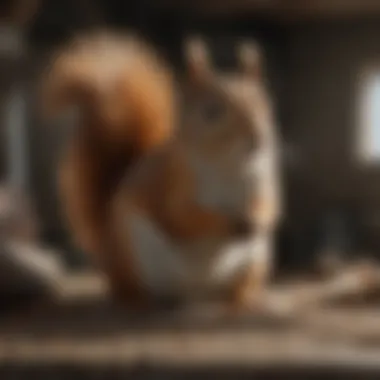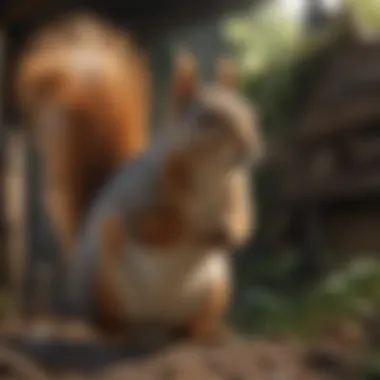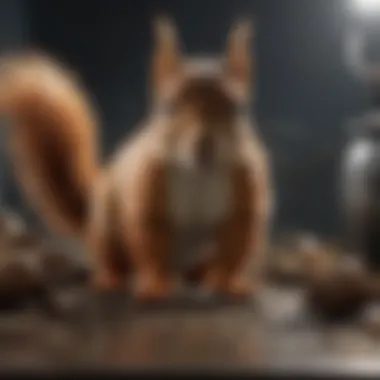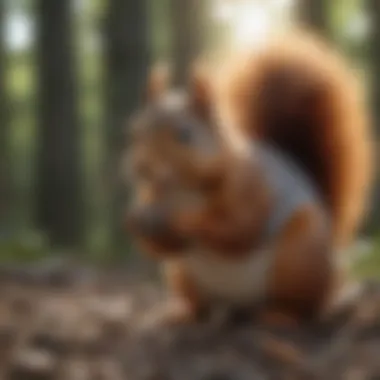Effective Strategies for Managing a Squirrel Encounter in Your Basement


Preventive Pest Control Strategies
When it comes to dealing with a potential squirrel intrusion in your basement, proactive measures play a vital role in preventing such unwanted guests. Prevention is the key to a pest-free home environment, and implementing effective pest control strategies can significantly reduce the likelihood of encountering these furry intruders. Let's delve into a comprehensive guide encompassing preventive pest control strategies to safeguard your home from wildlife invasions and pest infestations.
House Exterior Protection
To fortify your home against unwelcome visitors such as squirrels, it is essential to inspect and fortify the exterior of your property. Sealing cracks and crevices that may serve as potential entry points for pests is imperative. By using caulk or sealant, you can effectively block off access routes for squirrels and other critters. Additionally, clearing debris from the exterior of your home eliminates potential hiding spots for these pests, reducing the attractiveness of your property to them.
Yard Maintenance
Maintaining a well-kept yard goes a long way in warding off wildlife and pests from venturing too close to your home. Regular yard care routines such as mowing the lawn, trimming bushes, and pruning trees not only enhance the aesthetics of your property but also deter squirrels and other pests from establishing shelter near your home. Implementing methods to keep your yard pest-free, such as removing standing water that attracts pests, further minimizes the likelihood of encountering unwanted critters.
Indoor Cleanliness
Creating a pest-resistant indoor environment is crucial in preventing squirrel invasions. Expert cleaning tips and techniques, like proper waste management and regular vacuuming, can help eliminate potential food sources that may attract squirrels indoors. By maintaining cleanliness indoors, you reduce the appeal of your home to pests and discourage them from seeking refuge within your living spaces.
Garbage Disposal
Proper waste disposal methods are paramount in keeping pests, including squirrels, at bay. Ensuring that garbage bins are tightly sealed and that trash is promptly removed from your property minimizes the likelihood of attracting wildlife searching for food sources. By highlighting the importance of proper garbage disposal within your household, you further deter pests from lingering in close proximity to your home.
Other Pest Prevention Strategies
Innovative ways to safeguard your home against various pests are continually evolving. From utilizing electronic repellents to implementing natural deterrents like predator urine, exploring unconventional pest control methods can offer additional layers of protection against wildlife invasions. Staying informed about the latest pest prevention techniques empowers homeowners to proactively defend against potential pest threats.
Understanding Squirrel Behavior


Understanding squirrel behavior is crucial in effectively dealing with a squirrel in your basement. By comprehending the habits and tendencies of squirrels, you can devise strategies to tackle the situation efficiently. Recognizing why squirrels act the way they do helps homeowners navigate the process of removal with greater success. From understanding their nocturnal activities, nesting behaviors, to food preferences, a deep dive into squirrel behavior provides valuable insights for handling such encounters with confidence and care.
Squirrel Habits and Traits
Nocturnal Activities
Squirrels are known for their nocturnal activities, which involve being active during the night. This behavior plays a key role in the overall topic by impacting how homeowners approach squirrel removal. The nocturnal nature of squirrels means that they may be more active and harder to detect during late hours, influencing removal techniques and timing. Understanding nocturnal activities equips individuals with knowledge on when squirrels are most likely to be present and how to adapt removal strategies accordingly.
Nesting Behaviors
Squirrels exhibit specific nesting behaviors that are integral to grasping their behavior patterns. By understanding these behaviors, individuals can identify potential nesting sites and tailor removal approaches. Nesting behaviors, such as building nests and seeking secure locations, provide insights into squirrel preferences and movements within a property. Recognizing nesting behaviors aids in pinpointing areas where squirrels may be nesting, aiding in the effective removal process.
Food Preferences
Squirrels have distinct food preferences that influence their behavior. Understanding what attracts squirrels in terms of food is essential for both assessing their presence and implementing removal measures. By delving into their food preferences, homeowners can strategize on luring squirrels out for removal or implementing deterrent methods. Knowing the unique features of their food preferences guides individuals in creating effective tactics to manage squirrel encounters seamlessly.
Reasons for Squirrel Presence
Seeking Shelter
Seeking shelter is a common reason for squirrels to find their way into basements or attics. Understanding why squirrels seek shelter helps in addressing the root cause of their presence. By recognizing the appeal of sheltered spaces to squirrels, homeowners can proactively fortify entry points to prevent future intrusions. Exploring the unique features of seeking shelter sheds light on the motivations behind squirrel behavior, aiding in devising long-term solutions to discourage their presence.
Foraging for Food
Foraging for food is a primary driver for squirrels to explore new environments, including residential properties. Examining the behavior of foraging for food unveils the reasons behind their visits to basements in search of sustenance. Understanding how food availability influences squirrel behavior assists in creating environments that deter their foraging activities. By recognizing the advantages and disadvantages of foraging, homeowners can adopt practices that minimize attracting squirrels to their property.


Potential Nesting Grounds
Identifying potential nesting grounds is vital in understanding why squirrels choose specific locations for nesting. By exploring the characteristics of suitable nesting grounds, individuals can proactively safeguard their properties against infestations. Recognizing the advantages and disadvantages of these grounds equips homeowners with the knowledge needed to fortify vulnerabilities and deter squirrels from nesting on their premises. Understanding the allure of potential nesting grounds aids in implementing preventive measures to mitigate future squirrel intrusions.
Assessing the Situation
Assessing the situation when dealing with a squirrel in your basement is a crucial first step in handling the issue effectively. By understanding the behaviors and patterns of the squirrel, homeowners can determine the extent of the infestation and take appropriate action. This section delves into the importance of thoroughly assessing the situation to devise a strategic plan for safe and humane removal.
Locating the Squirrel
Identifying Possible Entry Points
Identifying possible entry points is key in determining how the squirrel gained access to the basement. Inspecting areas such as damaged vents, gaps in the foundation, or openings in the roof can provide valuable insights into the squirrel's entry path. By pinpointing these entry points, homeowners can effectively seal them off to prevent future intrusions, ensuring the safety and security of their property.
Observing Squirrel Behavior
Observing squirrel behavior can offer valuable information about the severity and nature of the infestation. By noting patterns such as repeated visits, nesting materials, or food hoarding, homeowners can gauge whether they are dealing with a single squirrel or a potential infestation. Understanding these behaviors can aid in devising appropriate removal tactics and safeguarding against safety risks associated with a larger squirrel presence.
Determining the Severity
Single Squirrel vs. Infestation
Distinguishing between a single squirrel and an infestation is essential in assessing the severity of the situation. While a lone squirrel may be easier to handle, an infestation can pose greater challenges and risks to the property. By identifying the scope of the issue, homeowners can implement targeted removal strategies and preventative measures to address the infestation effectively.
Safety Concerns


Safety concerns when dealing with squirrels in the basement encompass potential health risks and property damage. Squirrels can carry diseases and parasites that pose a threat to human health, making safe removal practices paramount. Additionally, their nesting behaviors can lead to structural damage and fire hazards. Addressing safety concerns promptly is critical in ensuring a secure environment and mitigating the negative impacts of a squirrel intrusion.
Safe Removal Techniques
When it comes to dealing with a squirrel in your basement, employing safe removal techniques is of paramount importance to ensure a humane resolution to the situation. This section focuses on elucidating the specific elements, benefits, and considerations surrounding safe removal techniques. By opting for humane methods, individuals not only uphold ethical practices but also safeguard the well-being of both the squirrel and themselves.
Non-Lethal Strategies
Setting Live Traps
Live traps are a crucial aspect of safe removal techniques as they allow for the capture of the squirrel without causing harm. The key characteristic of setting live traps is their ability to attract the squirrel using bait, effectively trapping them for later release. This method is highly favored for its humane approach, ensuring that the squirrel is unharmed during the removal process. However, an important consideration is to check the traps frequently to avoid prolonged entrapment that can cause stress to the squirrel.
Sealing Entry Points
Sealing entry points is a proactive approach that contributes significantly to the overall goal of safe squirrel removal. By identifying and sealing off potential entryways that the squirrel may be using to access your basement, you not only prevent further intrusions but also discourage other wildlife from entering. The key characteristic of this method is its deterrent effect, making your property less appealing to squirrels seeking shelter. While sealing entry points is an effective strategy, it is essential to conduct a thorough inspection to ensure all possible openings are properly secured.
Utilizing Repellents
Utilizing repellents serves as an additional tool in the arsenal of safe removal techniques. Repellents work by creating an unfavorable environment for squirrels, deterring them from inhabiting the space. The unique feature of repellents lies in their ability to influence the behavior of squirrels without causing direct harm. However, it is crucial to choose repellents that are safe for both humans and animals to avoid any negative repercussions. While repellents can be a valuable aid in encouraging squirrels to vacate your premises, they should be used in conjunction with other non-lethal strategies for optimal effectiveness.
Professional Assistance
Contacting Wildlife Experts
In some cases, seeking professional assistance from wildlife experts may be necessary to ensure the safe removal of squirrels from your basement. Wildlife experts possess the knowledge and experience required to handle squirrel infestations effectively. By contacting wildlife experts, individuals can benefit from specialized techniques and equipment that guarantee swift and humane removal. The unique feature of this approach is the expertise offered by professionals, reducing the risk of accidental harm to the squirrel or damage to your property.
Seeking Local Services
Seeking local services provides a convenient option for those who prefer to entrust the squirrel removal process to professionals within their community. Local services often specialize in wildlife relocation, offering tailored solutions to address squirrel infestations. The key characteristic of seeking local services is the personalized assistance that aligns with the specific requirements of your situation. While local services may incur a cost, the advantages lie in the expedited resolution and expert guidance provided by trained professionals.
Preventing Future Intrusions
As we address the issue of



